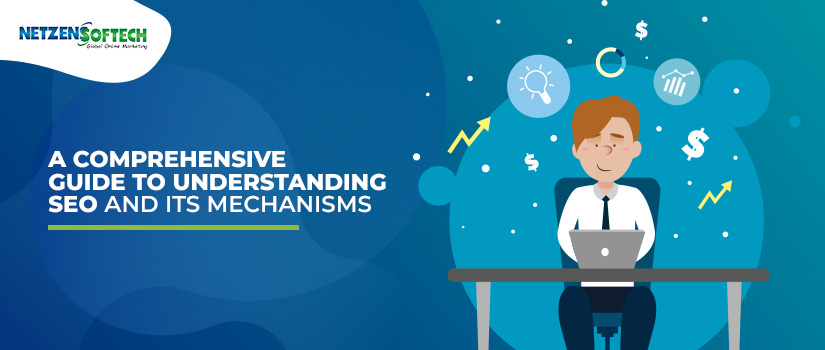Are you just getting started with SEO? Perhaps you’ve heard that SEO can boost your website’s rankings and increase traffic, but you’re not entirely sure how it operates or what areas to concentrate on. Then, you’ve come to the right place. Read on to find a comprehensive guide to understanding SEO and its mechanisms for every digital marketer.
You may have heard that SEO is crucial if you want to boost your website’s traffic.
The optimization of your website will help you rank higher and turn more searchers into paying customers.
But what exactly is SEO?
In this article, you will learn how you can optimize your website for search engines like Google, Bing, Yahoo, and others.
First, let’s start by being familiar with the basics of SEO.
What is SEO?

Let’s start by stating the obvious: What exactly is SEO? Search engine optimization, or SEO, is the technique of obtaining visitors via unpaid, editorial, organic, or natural search results in search engines. The purpose of it is to raise your website’s position in search results. Remember, the higher the website is listed, the more visible your business is, and the more viewers will see it.
The main goal of SEO is to increase a company’s visibility in organic search results. Increased website traffic for the business increases the likelihood that more visitors will convert to paying clients and customers.
In Google and other search engines, paid adverts are usually displayed first, followed by the regular results, or what search marketers refer to as the “organic search results.” SEO traffic is frequently referred to as “organic search traffic” to differentiate it from traffic that comes from paid search. Other terms for sponsored search include pay-per-click (PPC) and search engine marketing (SEM).
How Does Search Engine Optimization (SEO) Work?

Search engines like Google use an algorithm or set of rules to determine which pages to display for each query. These algorithms, which have grown immensely complex over time, take into account hundreds or even thousands of distinct ranking indications to determine the rankings of their SERPs. However, search engines use three crucial factors to determine a site’s quality and where it should rank:
- Links – Links from other websites have a big impact on how a website ranks in Google and other search engines. Since website owners are unlikely to link to low-quality websites, a link can be viewed as a vote of approval from other websites. Google refers to this as “PageRank” and considers websites with links from a lot of other websites to have authority, especially if the websites linked to them have the authority of their own.
- Content Relevancy – To determine if a webpage is relevant for a particular search query, search engines also look at the content of the page in addition to its links. An essential component of SEO is the generation of content that is targeted toward the keywords that users of search engines are using.
- Page Structure – The third key component of SEO is page structure. The organization of the HTML code may have an impact on how well a search engine understands a page because HTML is the language used to generate web pages. By including relevant keywords in the page’s title, URL, and headers as well as by making sure that a site is crawlable, website owners can take steps to improve the SEO of their website.
Each of these fundamental elements of search engine algorithms must be adjusted as part of the search engine optimization strategy in order to move them up the search results page.
Top Seach Engine Optimization Techniques
The first step to improving a site’s search rank is to understand how search engines work. Utilizing different SEO techniques to optimize the site for search is necessary to raise a site’s ranking:
- Keyword Research – Keyword research, which is typically the initial stage in SEO, includes looking at a site’s current ranking for specific keywords, its competitors’ rankings, and other terms that potential buyers are using to locate comparable goods or services. Finding the keywords that users enter into Google and other search engines can give guidance on what existing material should be optimized and what new content should be produced.
- Content Marketing – Content marketing is used after potential keywords are found. This can entail creating fresh content or improving already published material. Because Google and other search engines prioritize high-quality content, it’s essential to review existing content, create engaging content that provides a positive user experience, and boost your chances of ranking higher in search engine results.
- Link Building – Since links from other websites, or “backlinks” as they are known in SEO, are one of the main ranking factors in Google and other major search engines, obtaining high-quality backlinks is one of the most important SEO strategies. In order to accomplish this, it might be essential to advertise high-quality material, interact with other websites and develop relationships with webmasters, submit websites to relevant internet directories, and obtain press coverage in order to entice connections from other websites.
- On-page Optimization – In addition to off-page criteria like links, the webmaster has complete control over on-page elements like upgrading the page’s real structure, which can have a significant positive impact on SEO. Common on-page optimization techniques include changing the title tag of the website to include relevant search terms, optimizing the URL of the page to include keywords, and providing alt text for images.
Top Seach Engine Optimization Tools
Since SEO is a somewhat technical field, it depends on a number of applications and tools to help with website optimization. Here are some regularly used tools that are both free and paid for:
- Google Seach Console – The free Google tool known as Google Search Console (formerly “Google Webmaster Tools”) is a staple in the SEO toolbox. GSC assists in locating and resolving technical issues on the website and provides rankings and traffic reports for top keywords and pages.
- Google Ads Keyword Planner – The Keyword Planner for Google Ads is another free tool provided by Google as a part of its Google Ads service. It may be a great SEO tool despite being designed for paid search because it provides keyword suggestions and keyword search volume, both of which are helpful for performing keyword research.
- Backlink Analysis Tools – There are several link analysis tools available, with AHREFs and Majestic serving as the two most popular ones. Users can use backlink analysis tools to find new links while link building by looking at which websites link to their own or those of rivals.
- Social Media – The majority of social media platforms don’t directly affect SEO, but they can be useful for networking with other webmasters and developing relationships that can lead to opportunities for link-building and guest posting.
Tu Sum Up
Always keep in mind that SEO is never finished, even after your strategy has been fully implemented. In order to optimize your website for search engines, you may need to change your strategy in the middle of the process and wait to see the results. But with a solid SEO foundation in place, some perseverance, and a better client experience, the benefits of your SEO strategy ought to be clear. Finally, to learn and implement SEO in more depth, get in contact with the best SEO digital marketing company, Netzens Softech.
Also Read: The Definitive Guide to Moving Old Website to a New Domain Without Losing SEO



